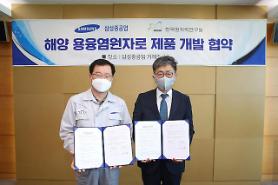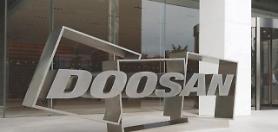
[Gettyimages Bank]
SEOUL -- South Korea's new energy policy to accelerate the development of advanced small modular reactors targeting foreign and domestic markets has become a target of attack from environmental activists who have campaigned for the dismantlement of hazardous nuclear facilities, big or small.
Small modular reactors (SMRs) have been studied to address the limitations of traditional light-water reactors using low-enriched uranium that cost a lot to replace nuclear fuel and require a vast emergency evacuation zone, nonproliferation and waste management. Small reactors designed with modular technology allow for less on-site construction, increased containment efficiency, and enhanced safety.
South Korea's nuclear power industry has seen an irrecoverable slump since President Moon Jae-in adopted a strong "nuclear-exit" policy to decrease the number of nuclear power plants from 24 to 14 in 2038. Doosan Heavy Industries & Construction and other companies involved in the nuclear industry have endeavored to find new business models such as SMRs.
In 2019, Doosan Heavy secured a deal from NuScale Power LLC of the United States to supply reactor modules, a key instrument for the power plant under development for Utah Associated Municipal Power Systems (UAMPS). They agreed to expand cooperation in the American and overseas markets. NuScale, headquartered in Portland, Oregon, designs and markets SMRs, based on a safer, smaller, and scalable version of pressurized water reactor technology.
At a policy meeting in December 2020, the government endorsed the development of an innovative small modular reactor (i-SMR) after a feasibility study. The biggest supporter was the Korea Atomic Energy Research Institute (KAERI), a state body that has striven hard to develop a competitive reactor with independent technology. "Small modular reactors are more receptive than large nuclear power plants and an eco-friendly technology that can replace gas generation in conjunction with renewable energy," Lim Chae-young, a senior KAERI researcher, said in a forum in April.
In a state-sponsored project, South Korean scientists are trying to design concepts for a micro modular reactor (MMR) that could be used for about 40 years without changing fuel. KAERI has partnered with Samsung Heavy Industries to develop a small carbon-free fission reactor based on molten salt that would be used for ships and floating nuclear power plants. Molten salt reactors (MSRs) can reduce expensive containment structures, eliminate hydrogen as a source of explosion risks, and do not produce radioactive fission gases.
"We are conducting long-term research with the goal of exporting rather than the domestic market," Lim said. Korea Hydro & Nuclear Power (KHNP), the operator of nuclear power plants, sent a cheer and called for concerted efforts by industrial and academic circles to develop an innovative small modular reactor with improved safety and economic feasibility. KAERI and KHNP aim to obtain a licensed model in 2028 before tapping foreign markets.
"We are confident that the Korean-style SMR will become the world's most competitive product in the SMR export market in the future if industrial and academic circles join forces for development based on our excellent technology," said KHNP CEO Chung Jae-hoon. Up until then, Chung's notion was not convincingly argued, but the atmosphere changed following summit talks between U.S. and South Korean leaders in Washington in May.
The joint statement issued at the end of summit talks contained a vague bilateral pledge to promote civil nuclear cooperation in markets abroad. Trade, Industry and Energy Minister Moon Sung-wook said at a presser on June 8 that the government would push for long-term research and development to solve the safety problem of next-generation nuclear power plants. "We will apply for a preliminary feasibility study on i-SMR for an improved third-generation version this fall."
Song Young-gil, leader of the ruling Democratic Party, followed up with a speech in parliament that he had proposed the need for strategic cooperation between Seoul and Washington in SMR and other areas ahead of summit talks. "With renewable energy alone, there is a limit to achieving complete carbon neutrality. For a considerable period of time, the energy mix using hydrogen and nuclear power is inevitable," he said.
Song described SMR as an "effective energy tool" for countries with geographical limitations, including North Korea. However, his idea caused a political debate, with a voice of opposition coming from some lawmakers and environmental activists who have supported the dismantlement of nuclear power plants.
The Korean Federation for Environmental Movement (KFEM), a leading anti-nuclear campaigner in South Korea, urged the government to stick to its original "nuclear-exit" policy and abandon the idea of developing SMR technology. "Stop developing small nuclear reactors and attempting to export nuclear power plants," the federation said in a statement. "The idea of developing SMR technology to take the lead in exports seems new, but it is the modified model of an old failure."
.
Copyright ⓒ Aju Press All rights reserved.


![[FOCUS] Doosans credit crisis raises new debate over dismantlement of nuclear power plants](https://image.ajunews.com/content/image/2020/04/02/20200402101526495148_278_163.jpg)
